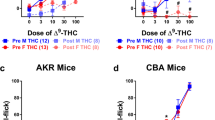Abstract
Rationale
Cannabinoids have been shown to produce greater behavioral effects in female than male rats. Although central nervous system CB1 receptors are known to mediate cannabinoid-induced behavioral effects in male rats, it is not known whether the same is true for females.
Objective
To determine if cannabinoid-induced antinociception and catalepsy are similarly mediated by central CB1 receptors in male and female rats.
Methods
The ability of SR141716A, a CB1 receptor selective antagonist, administered ICV (1–1000 μg) or IT (1–600 μg) to block 10 mg/kg IP Δ9-THC-induced antinociception (paw pressure) and catalepsy (bar test), was compared in male and female rats.
Results
Δ9-THC alone produced slightly greater antinociception, and significantly greater catalepsy in females than males. When administered ICV, SR141716A partially antagonized Δ9-THC-induced antinociception in both females and males. IT SR141716A also antagonized Δ9-THC-induced antinociception in both sexes; it was slightly more potent in males but equally effective in males and females. SR141716A antagonized Δ9-THC-induced catalepsy in a similar manner in males and females when given ICV or IT.
Conclusions
These results confirm that Δ9-THC-induced behavioral effects are mediated by central CB1 receptors in male and female rats.



Similar content being viewed by others
References
Borgen LA, Lott GC, Davis WM (1973) Cannabis-induced hypothermia: a dose-effect comparison of crude marihuana extract and synthetic Δ9-tetrahydocannabinol in male and female rats. Res Commun Chem Path Pharmacol 5:621–626
Cohn RA, Barnes PR, Barratt E, Pirch JH (1972) Sex differences in response to marijuana in the rat. In: Singh JM, Miller LH, Lal H (eds) Drug addiction experimental pharmacology, vol 1. Futura, New York, pp 227–234
Freeman ME (1998) The ovarian cycle of the rat. In: Knobil E, Neill J (eds) The physiology of reproduction. Raven, New York, pp 1893–1928
Gonzalez S, Bisogno T, Wenger T, Manzanares J, Milone A, Berrendero F, Di Marzo V, Ramos JA, Fernadez-Ruiz JJ (2000) Sex steroid influence on cannabinoid CB1 receptor mRNA and endocannabinoid levels in the anterior pituitary gland. Biochem Biophys Res Commun 270:260–266
Kenakin TP (1984) The classification of drugs and drug receptors in isolated tissues. Pharmacol Rev 36:165–222
Lichtman AH, Martin BR (1991) Spinal and supraspinal components of cannabinoid-induced antinociception. J Pharmacol Exp Ther 258:517–523
Lichtman AH, Martin BR (1997) The selective cannabinoid antagonist SR141716A blocks cannabinoid-induced antinociception in rats. Pharmacol Biochem Behav 57:7–12
Martin WJ, Lai NK, Patrick SL, Tsou K, Walker JM (1993) Antinociceptive actions of cannabinoids following intraventricular administration in rats. Brain Res 629:300–304
Mason DJ, Lowe J, Welch SP (1999) Cannabinoid modulation of dynorphin A: correlation to cannabinoid-induced antinociception. Eur J Pharmacol 378:237–248
Mize AL, Alper RH (2000) Acute and long-term effects of 17beta-estradiol on G(i/o) coupled neurotransmitter receptor function in the female rat brain as assessed by agonist-stimulated [35S]GTPgammaS binding. Brain Res 859:326–33
Moss DE, McMaster SB, Rogers J (1981) Tetrahydrocannabinol potentiates reserpine-induced hypokinesia. Pharmacol Biochem Behav 15:779–83
Narimatsu S, Watanabe K, Yamamoto I, Yoshimura H (1991) Sex difference in the oxidative metabolism of Δ9-tetrahydocannabinol in the rat. Biochem Pharmacol 41:1187–1194
Paxinos G, Watson C (1986) The rat brain in stereotaxic coordinates, 2nd edn. Academic Press, Sydney
Pugh G, Smith PB, Dombrowski DS, Welch SP (1996) The role of endogenous opioids in enhancing the antinociception produced by the combination of Δ9-tetrahydocannabinol and morphine in the spinal cord. J Pharmacol Exp Ther 279:608–616
Rinaldi-Carmona M, Barth F, Heaulme M, Shire D, Calandra B, Congy C, Martinez S, Maruani J, Neliat G, Caput D, Ferrara P, Soubrie P, Breliere JC, Le Fur G (1994) SR141716A, a potent and selective antagonist of the brain cannabinoid receptor. FEBS Lett 350:240–244
Rodriguez de Fonseca F, Cebeira M, Ramos JA, Martin M, Fernandez-Ruiz JJ (1993) Cannabinoid receptors in rat brain areas: sexual differences, fluctuations during the estrous cycle and changes after gonadectomy and sex steroid replacement. Life Sci 54:159–170
Sanudo-Pena MC, Strangman NM, Mackie K, Walker JM, Tsou K (1999) CB1 receptor localization in rat spinal cord and roots, dorsal root ganglion, and peripheral nerve. Zhongguo Yao Li Xue Bao 20:1115–1120
Torbati D, Ramirez J, Hon E, Camacho MT, Sussmane JB, Raszynski A, Wolfsdorf J (1999) Experimental critical care in rats: gender differences in anesthesia, ventilation, and gas exchange. Crit Care Med 27:1878–1884
Tseng AH, Craft RM (2001) Sex differences in antinociceptive and motoric effects of cannabinoids. Eur J Pharmacol 430:41–47
Tsou K, Nogueron MI, Muthian S, Sanudo-Pena MC, Hillard CJ, Deutsch DG, Walker JM (1998) Fatty acid amide hydrolase is located preferentially in large neurons in the rat central nervous system as revealed by immunohistochemistry. Neurosci Lett 254:137–140
Welch SP, Huffman JW, Lowe J (1998) Differential blockade of the antinociceptive effects of centrally administered cannabinoids by SR141716A. J Pharmacol Exp Ther 286:1301–1308
Acknowledgements
The authors thank Dr. M. Morgan for loan of the paw pressure apparatus, and Joseph Barrett for technical assistance. This research was supported by a grant from the National Institute on Drug Abuse (DA06036) to A.H.T.
Author information
Authors and Affiliations
Corresponding author
Rights and permissions
About this article
Cite this article
Tseng, A.H., Craft, R.M. CB1 receptor mediation of cannabinoid behavioral effects in male and female rats. Psychopharmacology 172, 25–30 (2004). https://doi.org/10.1007/s00213-003-1620-x
Received:
Accepted:
Published:
Issue Date:
DOI: https://doi.org/10.1007/s00213-003-1620-x




